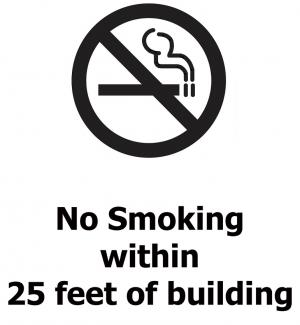Scope
Reduce exposure to environmental tobacco smoke (ETS) in multi-family buildings by:
- Prohibiting smoking in indoor common areas
- Locating designated outdoor smoking areas 25 feet from entries.
- Air sealing to minimize the spread of tobacco smoke between units.
See the Compliance Tab for links to related codes and standards and voluntary federal energy-efficiency program requirements.
Description
Environmental tobacco smoke (ETS), also known as secondhand smoke, is a mixture of the smoke given off by the burning end of a cigarette, pipe, or cigar, and the smoke exhaled by smokers. ETS contains over 4,000 substances, several of which are known to cause cancer in humans or animals (U.S. EPA).
ETS has been identified as a human lung carcinogen by EPA and also classified as a Group A carcinogen under EPA's carcinogen assessment guidelines. ETS is also responsible for approximately 3,000 lung cancer deaths annually among nonsmoking adults in U.S. In a number of studies, ETS exposure has also been shown to increase the risk of heart disease (U.S. EPA 1992).
Exposure to ETS can also adversely affect respiratory health in children and can cause asthma in children who have not previously exhibited symptoms. Additionally, ETS exposure in children increases the risks for Sudden Infant Death Syndrome, middle ear infections, and lower respiratory tract infections (such as pneumonia and bronchitis). EPA estimates that 150,000 to 300,000 cases of lower respiratory tract infections in infants and children up to 18 months of age can be attributed to ETS exposure (U.S. EPA 1992).
In multifamily buildings, ETS can be transferred into individual dwelling units through gaps and openings in walls, ceilings, and floors.
Eliminating ETS through a building-wide smoke-free policy is the most effective, and cost efficient, method of controlling ETS. There is no safe level of ETS exposure and no engineering technique can completely eliminate ETS infiltration.
Where eliminating smoking in new multifamily buildings is not immediately feasible, Indoor airPLUS requires that smoking be prohibited in all indoor common areas. Indoor airPLUS also requires that outdoor smoking areas be located a minimum of 25 feet from building entries, outdoor air intakes and operable windows. This restriction can be communicated through signage and building policies.
In order to minimize ETS infiltration between units, penetrations in the walls, ceilings, and floors of dwelling units should be sealed with appropriate materials. Vertical chases adjacent to dwelling units should also be fully sealed. All doors in dwelling units leading to common hallways should have weather stripping.
For more information about air sealing see the following guides:
Success
Building owners should establish a no-smoking policy that is clearly outlined in rental contracts.
Signs should be posted at all entrances indicating that smoking is prohibited within 25 feet of entryways, outdoor air intakes, and operable windows.
Climate
No climate specific information applies.
Compliance
Compliance
More
More Info.
Access to some references may require purchase from the publisher. While we continually update our database, links may have changed since posting. Please contact our webmaster if you find broken links.
The following authors and organizations contributed to the content in this Guide.
